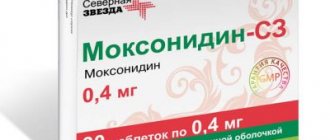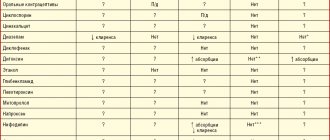Hydroxyzine Canon
Suction:
Absorption is high. The time to reach maximum concentration (Tcmax) after oral administration is 2 hours. After taking an average dose of 50 mg, Tcmax in adults is 70 mg/ml.
Distribution:
The distribution coefficient is 7-16 l/kg in adults. Hydroxyzine penetrates the blood-brain barrier and the placenta, concentrating more in fetal than maternal tissues. After oral administration, hydroxyzine penetrates well into the skin, with hydroxyzine concentrations in the skin far exceeding serum concentrations after both single and multiple doses. Plasma concentration of hydroxyzine does not necessarily reflect its tissue binding or distribution at skin receptors. It has an effect on skin inflammation depending on serum concentration.
Metabolism:
Hydroxyzine is metabolized in the liver. Cetirizine - the main metabolite (45%) is a blocker of H1-histamine receptors. Metabolites are found in breast milk.
Removal:
The half-life (T1/2) in adults is 14 hours (range: 7-20 hours). The total clearance of hydroxyzine is 13 ml/min/kg. About 0.8% of hydroxyzine is excreted unchanged through the kidneys. The main metabolite cetirizine is excreted mainly in the urine, also unchanged (25% of the dose of hydroxyzine).
Pharmacokinetics in special groups of patients
In elderly patients
In elderly patients T1/2 was 29 hours. The volume of distribution is 22.5 l/kg. It is recommended to reduce the daily dose of hydroxyzine when prescribed to elderly patients.
Children under 1 year
In children, the total clearance is 2.5 times higher than in adults. The dose must be adjusted. The half-life is 4 hours.
Children from 1 year to 14 years
The half-life is 11 hours.
In patients with liver failure
In patients with liver dysfunction secondary to primary biliary cirrhosis, the total clearance was approximately 66% of the value recorded in healthy volunteers. In patients with liver diseases, T1/2 increased to 37 hours, the concentration of metabolites in the blood serum was higher than in young patients with normal liver function. For patients with liver failure, a reduction in the daily dose or frequency of administration is recommended.
In patients with renal failure
The pharmacokinetics of hydroxyzine was studied in 8 patients with severe renal failure (creatinine clearance 24±7 ml/min). The duration of exposure to hydroxyzine did not change significantly, while the duration of exposure to cetirizine was increased. To avoid any significant accumulation of cetirizine metabolite after repeated use of hydroxyzine in patients with impaired renal function, the daily dose of hydroxyzine should be reduced.
Hydroxyzine Canon (25mg)
Pharmacodynamics
The active substance, hydroxyzine hydrochloride, is a diphenylmethane derivative, not chemically related to phenothiazines, reserpine, meprobamate or benzodiazepines.
Mechanism of action
Hydroxyzine hydrochloride does not inhibit the cerebral cortex, but its effect may be associated with suppression of the activity of some key areas of the subcortical region of the central nervous system.
Pharmacodynamic properties
Data on antihistamine and bronchodilator effects were obtained experimentally and confirmed clinically. The antiemetic effect was demonstrated both during the apomorphine test and the verilioid test.
Data from pharmacological and clinical studies indicate that hydroxyzine in therapeutic doses does not increase gastric secretion or acidity, and in most cases
cases exhibits moderate antisecretory activity. After intradermal injection of histamine or antigens to healthy adult volunteers and children, a decrease in rash and hyperemia was observed. Hydroxyzine also effectively reduced the severity of itching in various forms of urticaria, eczema and dermatitis.
If liver function is impaired, the antihistamine effect of a single dose of the drug can be extended up to 96 hours after administration.
EEG data from healthy volunteers demonstrate an anxiolytic-sedative profile of the drug. The anxiolytic effect has been confirmed in patients using various classical psychometric tests. Polysomnography data in patients with anxiety and those suffering from insomnia indicate an increase in total sleep duration, a decrease in the total time of night wakefulness and a reduction in sleep latency after daily single or repeated doses of 50 mg of the drug. When using the drug at a dose of 50 mg 3 times a day, a decrease in muscle tension was observed in patients in a state of anxiety. No memory impairment was noted. Not after 4 weeks of treatment in patients with anxiety.
Start of action
When using oral dosage forms, the antihistamine effect begins after approximately 1 hour. Sedation occurs 5-10 minutes after taking oral liquid forms and after 30-45 minutes when using tablets.
Hydroxyzine also has antispasmodic and sympatholytic effects. It exhibits weak affinity for muscarinic receptors. Hydroxyzine demonstrates moderate analgesic activity.
Pharmacokinetics
Suction
Absorption is high. The time to reach maximum concentration (TCmax) after oral administration is 2 hours. After taking a single dose of 25 mg, Cmax in adults is 30 ng/ml and 70 ng/ml after taking 50 mg of hydroxyzine. Bioavailability when taken orally is 80%.
Distribution
Hydroxyzine is more concentrated in tissues than in plasma. The distribution coefficient is 7-16 l/kg in adults. After oral administration, hydroxyzine penetrates well into the skin, with hydroxyzine concentrations in the skin exceeding serum concentrations after both single and multiple doses. Hydroxyzine penetrates the blood-brain barrier and the placenta, concentrating more in fetal than maternal tissues.
Metabolism
Hydroxyzine is extensively metabolized. The formation of the main metabolite of cetirizine, a carboxylic acid metabolite (approximately 45% of the oral dose), is regulated by alcohol dehydrogenase. This metabolite has pronounced antagonistic properties against peripheral H1 receptors. Other identified metabolites are an N-dealkylated metabolite and an O-dealkylated metabolite with a plasma half-life of 59 hours. These metabolic pathways are mainly regulated by CYP3A4/5.
Removal
The half-life (T1/2) in adults is 14 hours (range: 7-20 hours). The total clearance of hydroxyzine is 13 ml/min/kg. Only 0.8% of hydroxyzine is excreted unchanged by the kidneys. The main metabolite, cetirizine, is excreted mainly unchanged in the urine (25% of the administered dose of hydroxyzine).
Pharmacokinetics in special groups of patients
In elderly patients
The pharmacokinetics of hydroxyzine were studied in 9 healthy elderly people (69.5±3.7 years) after oral administration of a single dose of 0.7 mg/kg. In elderly people, T1/2 is extended to 29 hours, the volume of distribution increases to 22.5 l/kg. It is recommended to reduce the daily dose of hydroxyzine when prescribed to elderly patients.
In children
The pharmacokinetics of hydroxyzine was studied in 12 children after oral administration of a single dose of 0.7 mg/kg. In children, the total clearance is approximately 2.5 times shorter than in adults. The half-life of T1/2 is shorter than in adults and is 11 hours in children aged 14 years and 4 hours in children aged 1 year. The dose should be adjusted when used in children.
In patients with liver failure
In patients with liver dysfunction secondary to primary biliary cirrhosis, the total clearance was approximately 66% of the value recorded in healthy volunteers. In patients with liver disease, the T1/2 half-life increased to 37 hours and the concentration of metabolites in the blood serum was higher than in young patients with normal liver function.
For patients with liver failure, a reduction in the daily dose or frequency of administration is recommended.
In patients with renal failure
The pharmacokinetics of hydroxyzine was studied in 8 patients with severe renal failure (creatinine clearance 24±7 ml/min). The duration of exposure to hydroxyzine (AUC) was not significantly changed, while the duration of exposure to the carboxyl metabolite, cetirizine, was increased. Hemodialysis is not effective in removing this metabolite. To avoid any significant accumulation of cetirizine metabolite after repeated use of hydroxyzine, the daily dose of hydroxyzine should be reduced in patients with impaired renal function.

